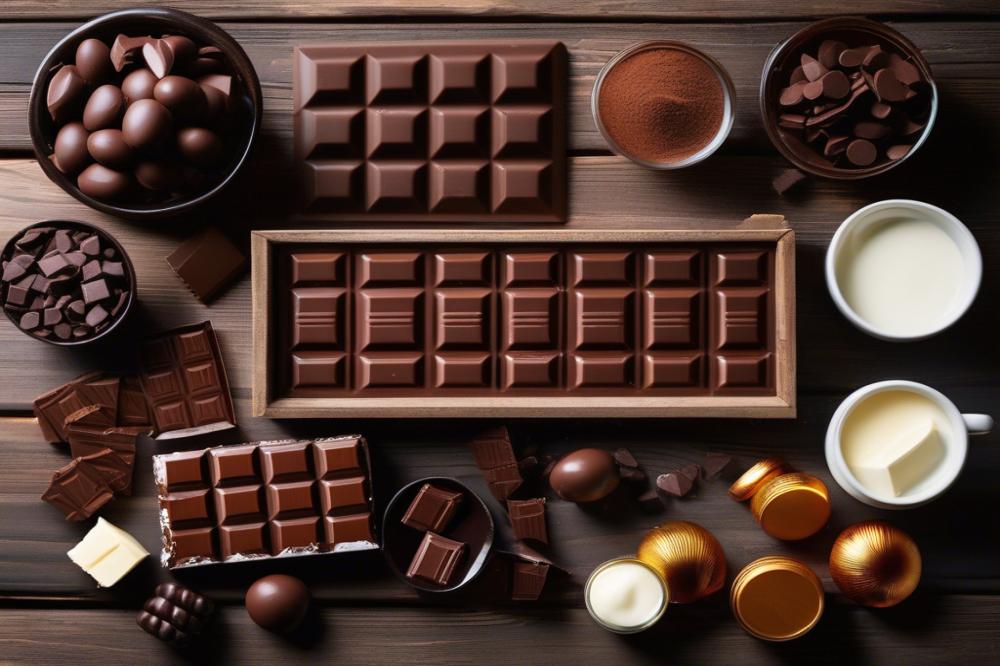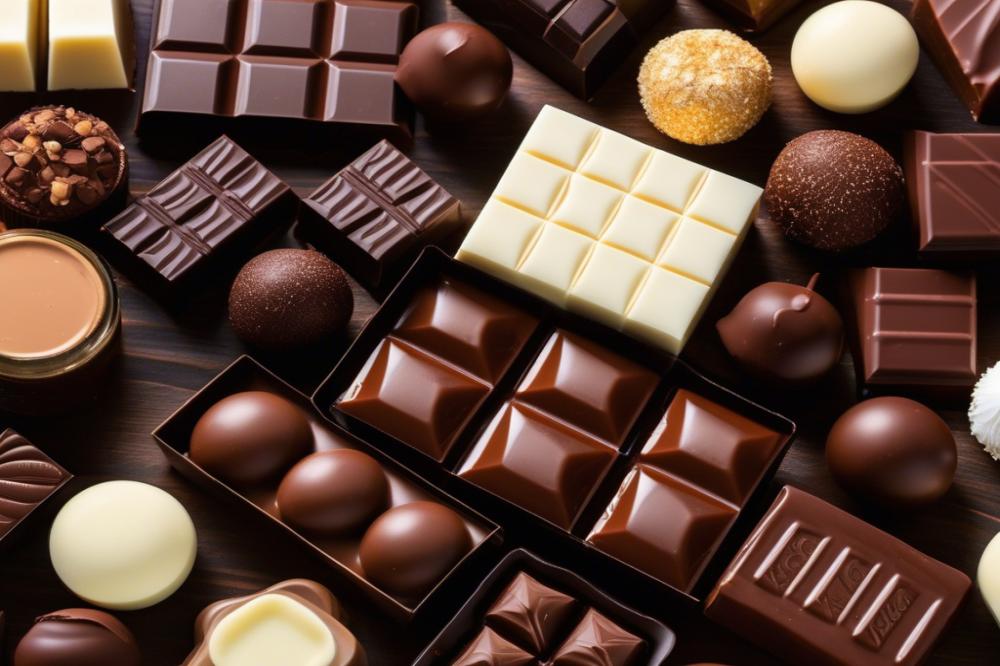Introduction
The chocolate industry is undergoing a remarkable transformation. Technological progress and a focus on innovation are leading the way for new trends in gastronomy. Consumers increasingly seek out products that are not only tasty but also visually striking and thoughtfully crafted. This demand for aesthetic appeal and quality fuels the evolution of confectionery.
innovation plays a critical role in driving change. food technology has introduced new methods and materials that challenge traditional approaches. Chefs and chocolatiers now have access to designer-level tools that enable them to push the boundaries of chocolate design. Through these advances, they create edible art that delights and surprises.
One recent development that stands out is the introduction of 3D printing in food creation. This technology allows artisans to sculpt intricate shapes that were once impossible to achieve. Customization becomes a breeze, as each piece can be created to meet specific customer preferences. This capability enhances the overall manufacturing process and has opened opportunities for unique creations in the world of sweets.
As culinary trends continue to unfold, the intersection of creativity and technology becomes more pronounced. Chocolate is not just a treat anymore; it is a medium for artistic expression. Today’s confectioners are using innovative design techniques to thrill their audiences and redefine the experience of enjoying chocolate. By embracing these advancements, the chocolate industry is poised to captivate taste buds and imaginations alike.
3D printing in chocolate design

The process of 3D printing is transforming many industries, and chocolate design is no exception. At its core, this innovation involves creating three-dimensional objects from a digital file. Layer by layer, materials are added until a final product emerges. In the case of food technology, the “ink” used is often chocolate, which can come in various flavors and colors. This method allows for intricate shapes and patterns that were once hard to produce by hand.
Integration of this technology into chocolate manufacturing has opened new avenues for creativity. Traditional techniques of sculpting chocolate relied heavily on the skills of artisans. Now, chocolatiers can use sophisticated software to design complex pieces that might be impossible to achieve otherwise. The shift toward automated processes not only speeds up production but also allows for precision in every detail. Custom molds and forms can be created in record time.
As a result, design techniques are evolving. Chocolatiers are experimenting with new styles, pushing boundaries in the culinary arts. Customization has become a major trend. It’s now possible to create personalized chocolate treats for special occasions, from weddings to corporate events. People can choose shapes, flavors, and decorations to reflect their preferences. This flexibility gives the consumer a sense of ownership over the product, which enhances the overall experience.
Benefits are numerous for both chocolatiers and consumers. For makers, it offers the chance to innovate without the limitations of traditional methods. They can produce small batches or even limited edition runs with ease. For buyers, the ability to personalize their chocolate adds a unique touch to any celebration. Edible art is becoming mainstream, and it excites the senses in ways that simple confections cannot. Culinary trends are increasingly leaning toward customization, and 3D printing is at the forefront of this movement.
Innovations in Edible Art

Food technology has revolutionized how chefs and artists approach the creation of chocolate. Using modern design techniques, they explore artistic possibilities that were previously unimaginable. Imagine a world where chocolate isn’t just a treat; it’s an artistic medium as well.
The rise of sculpting methods in confectionery allows for more intricate designs. Chocolatiers now craft stunning chocolate sculptures that captivate the eye and tantalize the taste buds. These creations range from delicate flowers to complex architectural marvels. Each piece not only looks fantastic but also offers a melt-in-your-mouth experience.
Examples of Notable Chocolate Designs
Some remarkable chocolate designs showcase the capabilities of today’s innovations. For instance, one famed chocolatier designed a life-sized replica of a beloved cartoon character. The attention to detail was astounding. Another example includes chocolate pieces inspired by famous landmarks, each meticulously crafted to reflect their real-world counterparts. These works of edible art are not just sweets; they are statements of creativity and craftsmanship.
The role of 3D printing in elevating confectionery art cannot be overstated. This technology allows for customization like never before. Artists can create detailed patterns and structures with precision that traditional methods simply cannot achieve. Gastronomy is experiencing a shift as chefs embrace these new possibilities. Far from ordinary, chocolate is now a canvas for personal expression.
By blending culinary trends with artistry, chocolate makers transform simple ingredients into masterpieces. The future of chocolate design looks bright as innovations continue to unfold. We are witnessing a new era where the boundaries of flavor and art merge seamlessly.
Customization and Personalization

3D printing technology offers endless possibilities for chocolate design. This innovation allows chocolatiers to create edible art that was once unimaginable. Through this advanced manufacturing approach, intricate shapes and customized textures become a reality. Consumers increasingly prefer products that reflect their personalities. Personalized chocolate gifts have become popular, especially for special occasions.
How 3D printing allows for unique chocolate designs
Gastronomy has taken a leap with the introduction of advanced design techniques. Chocolatiers can now experiment with sculpting chocolates that are both beautiful and delicious. The ability to design chocolates with precision means that shapes can cater to various themes. Whether it’s a birthday or a wedding, customized chocolates enhance the celebration. This flexibility in design means everyone can enjoy something that truly speaks to them.
Consumer preferences for personalized products
Today’s shoppers are more discerning than ever. They seek out products that stand out from the crowd. Personalization in the confectionery sector taps into this desire. Consumers want experiences that connect to their emotions. Chocolates that bear a personal touch are often treasured more than generic options. Their choices are influenced by trends, cultural relevance, and even memories tied to flavors.
Case studies of brands leveraging customization with 3D printing
Several brands have already embraced this trend. For instance, some chocolatiers offer designed chocolates that can be printed with names or messages. Others create sculptural pieces that reflect hobbies or professions. Consider a brand that partnered with a designer to create chocolates resembling iconic buildings. These collaborations show how art and food technology go hand in hand.
Future potential for bespoke chocolate creations
The future of chocolate design looks bright. As technology advances, the potential for bespoke creations expands. Tools for customization will likely become more accessible, allowing even home bakers to experiment. Imagine chocolate that not only tastes amazing but also matches your personal style. The intersection of culinary trends and technology promises exciting developments in the world of sweets.
Challenges and Considerations
Technical Limitations of 3D Printing in Food
Creating chocolate through printing is not without its hurdles. The technology can struggle with temperature control, which is crucial for maintaining the right consistency of chocolate. When the mixture is too warm, it may not hold its shape properly. Conversely, if it cools too quickly, the flow becomes restricted. Each model often requires specific designs that can complicate production. Moreover, achieving fine details in sculpting is challenging. The designs that look good on paper may not always translate well into edible art.
Regulatory Aspects and Food Safety Concerns
Compliance with food safety standards is essential. Regulations govern many aspects of food technology to protect consumers. This is especially true when innovation intersects with culinary practices. Ensuring that materials used in printing are safe for consumption adds another layer of scrutiny. Moreover, there can be anxiety around cross-contamination and hygiene. These factors may hinder businesses eager to adopt new design techniques in confectionery.
Sustainability Considerations in Chocolate Manufacturing
Sustainability poses another concern in chocolate production. Traditional manufacturing generates significant waste. On the other hand, 3D printing might reduce some of the excess, but it isn’t a cure-all. Energy consumption remains high in some printing processes, leading to questions of environmental impact. Furthermore, sourcing chocolate sustainably is paramount for those responsibly-minded consumers. It’s vital that any progress in innovation aligns with efforts to protect the planet.
Potential Market Barriers and Consumer Acceptance
Consumer acceptance of printed chocolates varies widely. Many individuals remain skeptical about the technology and its outcomes. Some may perceive it as a gimmick rather than a genuine advancement in gastronomy. Market barriers often revolve around the perception of quality versus traditional handcrafted items. Customers may worry that customization compromises taste or integrity. Striking a balance between innovation and craftsmanship can be a challenge for brands. Reaching out to educate the public could pave the way for greater acceptance in the future.
Culinary Trends and the Future of Chocolate
Emerging Trends in Food Technology and Gastronomy
Food technology is rapidly changing the way we think about confectionery. New tools and techniques are entering the kitchens of chefs and home bakers alike. These innovations open doors to creations that were once impossible. Shaping chocolate into intricate designs is now more feasible than ever. Chefs are experimenting with flavors and shapes, challenging traditional views of chocolate. Diners crave experiences that go beyond taste; they seek edible art that delights the eyes as well.
Predictions for the Future of 3D Printing in Chocolate
The future of chocolate design appears bright, especially with advanced manufacturing techniques. Sculpting chocolate in complex forms will gain popularity. Chefs will likely adopt these methods to elevate their menus. Customization will take center stage, as consumers desire personalized treats. Imagine chocolate sculptures tailored for special occasions or individual preferences. This trend could make special events even more memorable.
Influence of 3D Printing on Culinary Education and Skills
Culinary education must adapt to these advancements in technology. Training programs will incorporate modern design techniques into their curricula. Students will learn not just the art of baking, but also how to innovate in chocolate design. Skills like precision and creativity will be more crucial. As 3D printing becomes a norm, the future chefs will need to embrace change. Mastering these techniques could distinguish them in a competitive industry.
The Ongoing Evolution of the Chocolate Industry
The chocolate industry is not stagnant; it is evolving at a quick pace. As consumer preferences shift, manufacturers must keep up with these changes. Sustainability and ethical sourcing are becoming more important. More brands are focusing on high-quality ingredients and fair trade practices. These alterations reflect a broader shift in gastronomy, where customers demand transparency. Each piece of chocolate tells a story now, enriching the experience for all.
Ending Thoughts on Chocolate’s Evolution
Recap of 3D Printing’s Impact
The chocolate design landscape has experienced significant shifts due to advancements in technology. Artists and chocolatiers now craft intricate shapes and forms that were once impossible. This ability to create customized pieces allows for a greater expression of creativity. Traditional methods are being complemented, if not replaced, by these higher-tech approaches. As a result, both producers and consumers enjoy a more engaging experience.
Looking Ahead: The Future of Chocolate
Future innovations will likely expand the possibilities for chocolate creations. Areas like food technology open doors to new flavors, textures, and even healthier options. Such changes will change how people perceive and enjoy chocolate. With technology evolving rapidly, the chocolate industry stands on the brink of a new era. Exciting prospects await those who dare to experiment.
Call to Action for Industry Players
It is crucial for industry stakeholders to embrace this shift. Chocolatiers should explore these new methods, allowing for fresh ideas and products. Collaboration among tech developers and creators can foster greater advancements. As chocolate enthusiasts, we urge you to support these innovations. Together, let us reshape the future of chocolate in ways that delight and inspire.



